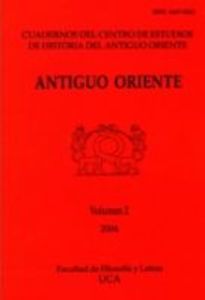Por favor, use este identificador para citar o enlazar este ítem:
https://repositorio.uca.edu.ar/handle/123456789/11792| Campo DC | Valor | Lengua/Idioma |
|---|---|---|
| dc.contributor.author | Paysás, Javier M. | es |
| dc.coverage.spatial | Irán antiguo | es |
| dc.coverage.spatial | Grecia | es |
| dc.date.accessioned | 2021-07-05T17:54:14Z | - |
| dc.date.available | 2021-07-05T17:54:14Z | - |
| dc.date.issued | 2004 | - |
| dc.identifier.citation | Paysás, J. M. Algunos aportes iconográficos, simbólicos y litúrgicos iranios al Imperio Romano y al Cristianismo [en línea]. Antiguo Oriente. Cuadernos del Centro de Estudios de Historia del Antiguo Oriente. 2004, 2. Disponible en: https://repositorio.uca.edu.ar/handle/123456789/11792 | es |
| dc.identifier.issn | 1667-9202 | - |
| dc.identifier.uri | https://repositorio.uca.edu.ar/handle/123456789/11792 | - |
| dc.description.abstract | Abstract: The ancient Iranian cultural heritage to the Roman Empire and early Christianism includes iconographic, symbolic and liturgical aspects. For instance, the Iranian world manifests a strong tendency to frontal representation in artistic work, from Scythians and Cimmerians to Parthians and Sassanians, especially in the representation of divinities and kings. These aspects reached Syria and it is plausible that from there they passed to North Africa and Asia Minor, and finally to Rome. Besides the iconographical frontal disposition, a special type of throne, the radiated nimbus and a particular round puffin were the legacy of the ancient Iranian world to the Byzantine Empire and Medieval Western Europe. Those were symbols of power and majesty, related to the iconography of kings and deities. In the same way, the posture of Sassanian kings seated on their thrones, resembles those of the medieval kings. Besides the iconographical legacy, several religious ideas of Judaism and Christianism received the influence of Mazdean conceptions, especially those related to the judgement of souls in the Netherworld and the eternal struggle between angels and daemons. | es |
| dc.format | application/pdf | es |
| dc.language.iso | spa | es |
| dc.publisher | Universidad Católica Argentina. Facultad de Filosofía y Letras. Centro de Estudios de Historia del Antiguo Oriente | es |
| dc.rights | Acceso abierto | * |
| dc.rights.uri | http://creativecommons.org/licenses/by-nc-sa/4.0/ | * |
| dc.source | Antiguo Oriente. Cuadernos del Centro de Estudios de Historia del Antiguo Oriente No.2, 2004 | es |
| dc.subject | ICONOGRAFIA | es |
| dc.subject | IMPERIO ROMANO | es |
| dc.subject | IMPERIO BIZANTINO | es |
| dc.subject | CRISTIANISMO | es |
| dc.subject | HISTORIA CULTURAL | es |
| dc.title | Algunos aportes iconográficos, simbólicos y litúrgicos iranios al Imperio Romano y al Cristianismo | es |
| dc.type | Artículo | es |
| uca.disciplina | HISTORIA | es |
| uca.issnrd | 1 | es |
| uca.affiliation | Fil: Paysás, Javier M. Pontificia Universidad Católica Argentina; Argentina | es |
| uca.affiliation | Fil: Paysás, Javier M. El Centro de Estudios del Egipto y del Mediterráneo Oriental; Argentina | es |
| uca.affiliation | Fil: Paysás, Javier M. Fundación Hernandarias; Argentina | es |
| uca.version | publishedVersion | es |
| item.grantfulltext | open | - |
| item.fulltext | With Fulltext | - |
| item.languageiso639-1 | es | - |
| Aparece en las colecciones: | AO - 2004 nro.2 | |
Ficheros en este ítem:
| Fichero | Descripción | Tamaño | Formato | |
|---|---|---|---|---|
| algunos-aportes-iconograficos-simbolicos.pdf | 795,31 kB | Adobe PDF | Visualizar/Abrir | |
| antiguo_oriente02.pdf.jpg | 2,87 kB | JPEG |  Visualizar/Abrir |
Visualizaciones de página(s)
214
comprobado en 30-abr-2024
Descarga(s)
480
comprobado en 30-abr-2024
Google ScholarTM
Ver en Google Scholar
Este ítem está sujeto a una Licencia Creative Commons

